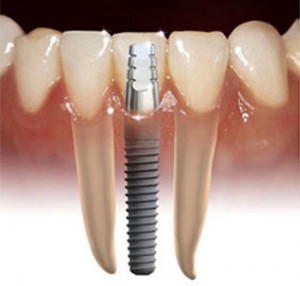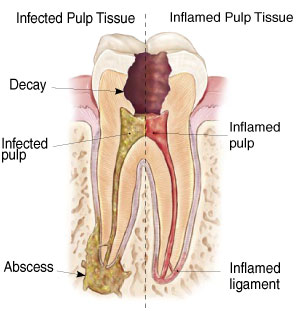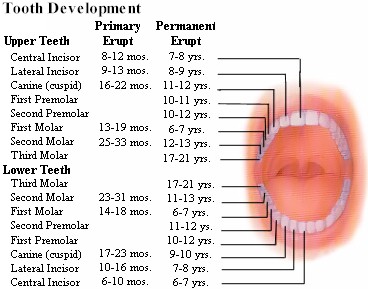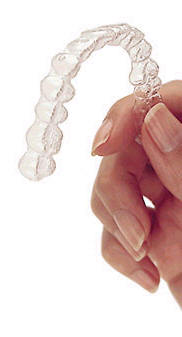Adult Dentistry
- How Often Should I Visit the Dentist?
- Bridges
- Bruxism “Tooth Grinding”
- Crowns
- EMERGENCIES
- Implants
- Oral Cancer
- Root Canal Treatment (Endodontics)
- Tooth Eruption
- Tobacco Use
- Tongue Piercing
- Wisdom Teeth
For more information concerning dentistry, please visit the website for the American Dental Association.
General Topics & Procedures
How Often Should I Visit the Dentist?
The American Dental Association (ADA) recommends visits to the dentist at least once every six months for a professional exam and cleaning. Regular dental visits are necessary for the maintenance of healthy gums and teeth. Your dentist may recommend more frequent visits, depending on the status of your oral health.
Bridges
When one or more teeth are missing, the remaining teeth can shift out of position, which can lead to a change in your bite, the loss of additional teeth, decay and gum disease.
In the case of missing teeth, your dentist may recommend the placement of a bridge. A permanent bridge is one or more replacement teeth anchored by one or more crowns on each side. A removable bridge, or removal partial denture, usually consists of replacement teeth attached to pink or gum-colored plastic bases, which are connected by metal framework.
Bruxism – “Tooth Grinding”
Patients are often concerned about the nocturnal grinding of teeth (bruxism). Often, the first indication is the noise created by the grinding on your teeth during sleep. Or, you may notice wear (teeth getting shorter) to the dentition. One theory as to the cause of grinding is stress. Another theory relates to pressure in the inner ear at night.
The majority of cases of bruxism do not require any treatment. If excessive wear of the teeth (attrition) is present, then a mouth guard (night guard) may be indicated.
Crowns
A crown can be used to cover a fractured tooth, a tooth with a large, old filling, or a tooth that is severely damaged by decay. Crowns strengthen and protect the remaining tooth structure and can improve the appearance of your smile. Crowns are also used to cover teeth that are discolored or badly shaped or to cover a dental implant. Types of crowns include the full porcelain crown, the porcelain-fused-to-metal crown and the all-metal crown. Your dentist can recommend the crown that is best for you.
Fitting a crown requires at least two visits to your dentist. Initially, the dentist removes decay and shapes the tooth. Then he makes an impression and fits a temporary or transitional crown of plastic or metal. On the next visit your dentist will remove the temporary crown, fit and adjust the final crown, then cement it into place.
Emergencies
Toothache: Clean the area of the affected tooth thoroughly. Rinse the mouth vigorously with warm water or use dental floss to dislodge impacted food or debris. DO NOT place aspirin on the gum or on the aching tooth. If face is swollen apply cold compresses. Take the child to a dentist.
Cut or Bitten Tongue, Lip or Cheek: Apply ice to bruised areas. If there is bleeding apply firm but gentle pressure with a gauze or cloth. If bleeding does not stop after 15 minutes or it cannot be controlled by simple pressure, take child to hospital emergency room.
Knocked Out Permanent Tooth: Find the tooth. Handle the tooth by the crown, not the root portion. You may rinse the tooth but DO NOT clean or handle the tooth unnecessarily. Inspect the tooth for fractures. If it is sound, try to reinsert it in its socket. Have the patient hold the tooth in place by biting on a gauze. If you cannot reinsert the tooth, transport the tooth in a cup containing the patient’s saliva or milk. The tooth may also be carried in the patient’s mouth. The patient must see a dentist IMMEDIATELY! Time is a critical factor in saving the tooth.
Implants
 Tooth
loss can have an effect on your dental health and personal
appearance if not dealt with properly. When you lose or have one or
more permanent teeth extracted, your remaining teeth can drift out
of position. This can lead to a change in your bite, and/or decay
and gum disease, not to mention a change in your personal
appearance.
Tooth
loss can have an effect on your dental health and personal
appearance if not dealt with properly. When you lose or have one or
more permanent teeth extracted, your remaining teeth can drift out
of position. This can lead to a change in your bite, and/or decay
and gum disease, not to mention a change in your personal
appearance.
Dental implants are an effective method in replacing one or several teeth. Each implant consists of a metal post that is inserted into the jawbone under your gums. During a healing period, the bone grows around the implant. Then the post is outfitted with an artificial tooth, which is similar to your natural tooth. Implants can also support a bridge, replace a partial denture or secure a fixed denture.
Oral Cancer
According to the American Dental Association (ADA), oral cancer kills more people nationwide than either cervical cancer or melanoma (skin cancer). Currently only half of all patients diagnosed with oral cancer survive more than five years. Good news is that it is now easier than ever to detect oral cancer early, when the opportunity for a cure is great.
Regular dental check-ups are essential in the early detection of cancerous and pre-cancerous conditions. You may have a very small, but dangerous, oral spot or sore and not be aware of it. In about 10% of patients, the dentist may notice a flat, painless, white or red spot or a small sore. Although most of these are harmless, some are not. To ensure that a spot or sore is not dangerous, your dentist may choose to perform a simple test, a biopsy, which can detect potentially dangerous cells when the disease is still at an early stage.
Signs of oral cancer that you may want to be aware of may include:
- a sore that bleeds easily or does not heal
- a color change of the oral tissue
- a lump, thickening, rough spot, rust or small eroded area
- pain, tenderness, or numbness anywhere in the mouth or on the lips
Although oral cancer occurs most often in those who use tobacco in any form, more than 25% of oral cancers occur in people who do not smoke and have no other risk factors.
Remember to see your dentist regularly because in many parts of the mouth you may not be able to see a small spot or sore yourself. If you do notice any of the above signs, you should call your dentist as soon as possible.
Root Canal Treatment (Endodontics)
To understand endodontic treatment, it helps to know something about the anatomy of the tooth. Inside the tooth, under the white enamel and a hard layer called the dentin, is a soft tissue called the pulp. The pulp contains blood vessels, nerves, and connective tissue and creates the surrounding hard tissues of the tooth during development. The pulp extends from the crown of the tooth to the tip of the roots where it connects to the tissues surrounding the root. The pulp is important during a tooth’s growth and development. However, once a tooth is fully mature it can survive without the pulp, because the tooth continues to be nourished by the tissues surrounding it.
 Endodontic
treatment is necessary when the pulp becomes inflamed or infected.
The inflammation or infection can have a variety of causes: deep
decay, repeated dental procedures on the tooth, or a crack or chip
in the tooth. In addition, a blow to a tooth may cause pulp damage
even if the tooth has no visible chips or cracks. If pulp
inflammation or infection is left untreated, it can cause pain or
lead to an abscess.
Endodontic
treatment is necessary when the pulp becomes inflamed or infected.
The inflammation or infection can have a variety of causes: deep
decay, repeated dental procedures on the tooth, or a crack or chip
in the tooth. In addition, a blow to a tooth may cause pulp damage
even if the tooth has no visible chips or cracks. If pulp
inflammation or infection is left untreated, it can cause pain or
lead to an abscess.
Signs of pulp damage include pain, prolonged sensitivity to heat or cold, discoloration of the tooth, and swelling and tenderness in the nearby gums. Sometimes, there are no symptoms.
When a root canal is necessary, the dentist, or endodontist removes the inflamed or infected pulp, carefully cleans and shapes the inside of the tooth, then fills and seals the space. Afterwards, you will return to your dentist who will place a crown or other restoration on the tooth to protect and restore it. After restoration, the tooth continues to function like any other tooth.
Tooth Eruption
Children’s teeth begin forming before birth. As early as 4 months, the first primary (or baby) teeth to erupt through the gums are the lower central incisors, followed closely by the upper central incisors. Although all 20 primary teeth usually appear by age 3, the pace and order of their eruption varies.
Permanent teeth begin appearing around age 6, starting with the first molars and lower central incisors. This process continues until approximately age 21.
Adults have 28 permanent teeth, or up to 32 including the third molars (or wisdom teeth).

Tobacco Use
Tobacco in any form can jeopardize your health and cause incurable damage. Smokeless tobacco, also called spit, chew or snuff, is often used by teens who believe that it is a safe alternative to smoking cigarettes. This is an unfortunate misconception. Studies show that spit tobacco may be more addictive than smoking cigarettes and may be more difficult to quit. People who use it may be interested to know that one can of snuff per day delivers as much nicotine as 60 cigarettes. In as little as three to four months, smokeless tobacco use can cause periodontal disease and produce pre-cancerous lesions called leukoplakias.
If you are a tobacco user you should watch for the following that could be early signs of oral cancer:
- A sore that won’t heal
- White or red leathery patches on your lips, and on or under your tongue
- Pain, tenderness or numbness in the mouth or lips
- Difficulty chewing, swallowing, speaking or moving your jaw or tongue; or a change in the way your teeth fit together
Because the early signs of oral cancer usually are not painful, people often ignore them. If it’s not caught in the early stages, oral cancer can require extensive, sometimes disfiguring, surgery. Even worse, it can kill.
The best advice is to avoid tobacco in any form. By doing so, you will avoid bringing cancer-causing chemicals in direct contact with your tongue, gums and cheek.
Tongue Piercing
You might not be surprised anymore to see people with pierced tongues, lips or cheeks, but you might be surprised to know just how dangerous these piercings can be.
There are many risks involved with oral piercings including chipped or cracked teeth, blood clots, or blood poisoning. Your mouth contains millions of bacteria, and infection is a common complication of oral piercing. Your tongue could swell large enough to close off your airway!
Common symptoms after piercing include pain, swelling, infection, an increased flow of saliva and injuries to gum tissue. Difficult-to-control bleeding or nerve damage can result if a blood vessel or nerve bundle is in the path of the needle.
So follow the advice of the American Dental Association and give your mouth a break – skip the mouth jewelry.
Wisdom Teeth
Wisdom teeth, or third molars, are the final teeth to develop in the back of your mouth. Most people have four wisdom teeth, which erupt during our late teens or early twenties.
Oftentimes, problems develop that require the removal of your wisdom teeth. When the jaw isn’t large enough to accommodate them, they can become trapped or impacted. Wisdom teeth may grow sideways, emerge only part way from the gum or remain trapped beneath the gum and bone. In most cases, it is recommended that impacted wisdom teeth are extracted (removed).
Wisdom tooth surgery is performed, usually under local anesthesia, in your dentist’s or oral surgeon’s office, an outpatient surgical facility, or a hospital.
Prevention
Fluoride
Fluoride is an element, which has been shown to be beneficial to teeth. However, too little or too much fluoride can be detrimental to the teeth. Little or no fluoride will not strengthen the teeth to help them resist cavities. Excessive fluoride ingestion by preschool-aged children can lead to dental fluorosis, which is a chalky white to even brown discoloration of the permanent teeth. Many children often get more fluoride than their parents realize. Being aware of a child’s potential sources of fluoride can help parents prevent the possibility of dental fluorosis.
Some of these sources are:
- Too much fluoridated toothpaste at an early age.
- The inappropriate use of fluoride supplements.
- Hidden sources of fluoride in the child’s diet.
Two and three-year olds may not be able to expectorate (spit out) fluoride-containing toothpaste when brushing. As a result, these youngsters may ingest an excessive amount of fluoride during tooth brushing. Toothpaste ingestion during this critical period of permanent tooth development is the greatest risk factor in the development of fluorosis.
Excessive and inappropriate intake of fluoride supplements may also contribute to fluorosis. Fluoride drops and tablets, as well as fluoride fortified vitamins should not be given to infants younger than six months of age. After that time, fluoride supplements should only be given to children after all of the sources of ingested fluoride have been accounted for and upon the recommendation of your pediatrician or pediatric dentist.
Certain foods contain high levels of fluoride, especially: powdered concentrate infant formula, soy-based infant formula, infant dry cereals, creamed spinach, and infant chicken products. Please read the label or contact the manufacturer. Some beverages also contain high levels of fluoride, especially: decaffeinated teas, white grape juices, and juice drinks manufactured in fluoridated cities. Blending the syrup, carbonation and the city water supply often makes soft drinks at fast food restaurants – so if fluoride is in the water – this is another source.
Parents can take the following steps to decrease the risk of fluorosis in their children’s teeth:
- Use baby tooth cleanser on the toothbrush in the very young child.
- Place only a pea-sized drop of children’s toothpaste on the brush when brushing.
- Account for all of the sources of ingested fluoride before requesting fluoride supplements from your child’s physician or pediatric dentist.
- Avoid giving any fluoride-containing supplements to infants until they are 6 months old.
- Obtain fluoride level test results for your drinking water before giving fluoride supplements to your child (check with local water utilities).
Good Diet
Healthy eating habits lead to healthy teeth. Like the rest of the body, the teeth, bones and the soft tissues of the mouth need a well-balanced diet. In order to promote good dental health, we should eat a variety of foods from the five major food groups. Most snacks that we eat can lead to cavity formation. The more frequently we snack, the greater the chance for tooth decay. How long food remains in the mouth also plays a role. For example, hard candy and breath mints stay in the mouth a long time, which cause longer acid attacks on tooth enamel. If you must snack, choose nutritious foods such as vegetables, low-fat yogurt, and low-fat cheese, which are healthier and better for your teeth.
Mouth Guards
If you participate in recreational activities and organized sports, injuries can occur. A properly fitted mouth guard, or mouth protector, is an important piece of athletic gear that can help protect your smile, and should be used during any activity that could result in a blow to the face or mouth.
Mouth guards help prevent broken teeth, and injuries to the lips, tongue, face or jaw. A properly fitted mouth guard will stay in place while you are wearing it, making it easy for you to talk and breathe.
Ask your dentist about custom and store-bought mouth protectors.
Seal Out Decay
A sealant is a clear or shaded plastic material that is applied to the chewing surfaces (grooves) of the back teeth (premolars and molars), where four out of five cavities in children are found. This sealant acts as a barrier to food, plaque and acid, thus protecting the decay-prone areas of the teeth.
Cosmetic or Esthetic Dentistry
Bonding
Bonding restores chipped, cracked, miscolored or misaligned teeth by rebuilding the surface with a resin material. To place the bond, your dentist prepares your tooth with an etching solution. Then special resin materials are blended in colors carefully chosen to match your own teeth. These materials are applied to your teeth, then shaped into just the right contours. Finally, they’re hardened or bonded in place. Bonding provides wonderful results at an affordable cost.
Inlays and Onlays
Tooth-colored restorations that are used on the chewing surfaces of the back teeth. They can be placed instead of silver fillings or to replace existing silver fillings.
 Invisalign®
Invisalign®
The invisible way to straighten your teeth, without braces.
Invisalign® can give you the beautiful straight teeth you’ve always wanted. It works through a series of invisible, removable, and comfortable aligners that no one can tell you’re wearing. So you can smile more during treatment as well as after. Invisalign® has been proven effective in clinical research and in dental and orthodontic practices nationwide.
How Does Invisalign® Work?
- You wear each set of aligners for about 2 weeks, removing them only to eat, drink, brush, and floss.
- As you replace each aligner with the next in the series, your teeth will move – little by little, week by week – until they have straightened to the final position your orthodontist or dentist has prescribed.
- You’ll visit us about once every 6 weeks to ensure that your treatment is progressing as planned.
- Total treatment time averages 9-15 months and the average number of aligners worn during treatment is between 18 and 30, but both will vary from case to case.
Veneers
Veneers are thin, custom-made shells crafted of tooth-colored materials designed to cover the front side of teeth. Porcelain laminate veneers are commonly used to correct teeth that are stained or discolored, badly shaped or crooked, or damaged due to an injury.
Placing a veneer is usually an irreversible process, because it’s necessary to remove a small amount of enamel from your teeth to accommodate the shell.
Whitening (Bleaching)
Several options are available to help make your smile brighter and whiter. In-office bleaching, at-home bleaching, or whitening toothpastes. Ask your dentist which technique is the best suited for you.
Zoom!™ Teeth Whitening
 Do
you want to Zoom!™?
Do
you want to Zoom!™?
The Zoom! In-Office Whitening System is a revolutionary tooth whitening procedure. It’s safe effective and fast, very fast. In just over an hour, your teeth will be dramatically whiter. Zoom! Whitening is ideal for anyone looking for immediate results. The convenience of Zoom! in comparison to days of wearing trays and gradual whitening makes it the perfect choice for the busy individual.
-

- Before Zoom
Get ready to Zoom!
The Zoom! Whitening procedure is simple and painless. It begins with a short preparation to isolate your lips and gums. The Zoom! clinician then applies the proprietary Zoom! Whitening Gel, which is activated by a specially designed light. Teeth typically become at least six to ten shades whiter, sometimes more. A five-minute fluoride treatment competes the procedure. You’ll be amazed with the results. In most cases, teeth get even whiter the first few days after the procedure.
-

- After Zoom
How Zoom! Works!
The Zoom! light activated gel was developed after years of research by Discus Dental, the leaders in professional take-home tooth whitening. The gel is a scientifically formulated, pH balanced Hydrogen Peroxide that, when activated by the Zoom! light, gently penetrates the teeth to remove deep stains and discoloration. With proper care and an occasional touch-up at home, your whiter smile will sparkle for years.





